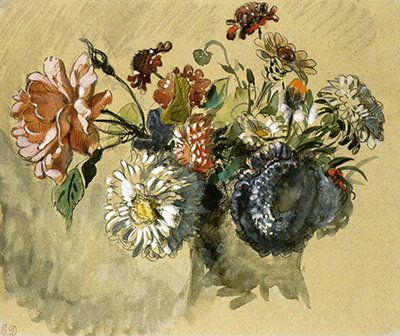This still life floral display from Delacroix was carried out in 1843, though looks most likely to have been a study piece for a later work, with the background entirely ignored and the vase in which the flowers sit also incomplete.
Eugene Delacroix was an artist who constantly sought new challenges within his career and did not like to focus on one single genre for too long. Few have provided such a broad array of work within their careers as this French painter who is most famous for his work in Romanticism but also touched on other styles many times. There are landscapes, portraits and also the still life paintings found here as he continued to experiment in order to push his own technical abilities. He was clearly able, somehow, to master all of these challenges, and perhaps this was down to a combination of his own considerable talent as well as the exceptional training that he received as a young man. His curiosity was also strong and this encouraged him to proactively seek out alternative styles from outside the boundaries of his native France.
In stark contrast to Bouquet of Flowers, 1850, the arrangement found here is much simpler. There are two main flower heads that lean to the left and these take your focus initially. There is then a collection of small heads which sit densely together around the rim of the vase. Some of these are only partially filled with solid colour, meaning the paper behind shows through. This is typical of a study artwork, be it oils, watercolours or even a pencil sketch. There are then some strokes of darker tones for the background but these are far from finished, as is the vase itself which is more of a suggestion of form than a completed finish. Academics will have studied this artwork in order to better understand the working processes of the artist, with most completed paintings, especially those in oils, hiding much of the work behind layers and layers of paint over the top.
This artwork is now to be found at the Musée Fabre, Montpellier, France. Sadly, their website does not appear to feature any detail on this painting but they do discuss some of their other notable pieces, such as Bonjour, Monsieur Courbet, which is one of Gustave Courbet's most famous paintings, as well as Vue of the village by Frédéric Bazille and also Frédéric Bazille at his Easel by Pierre-Auguste Renoir. As you might imagine, there is a clear focus on French art, specifically from the past two centuries and few will be disappointed with a visit to this fine establishment. Check ahead if you are looking to view a specific piece in person, and the display will be rotated from time to time.




